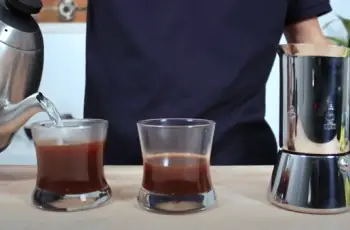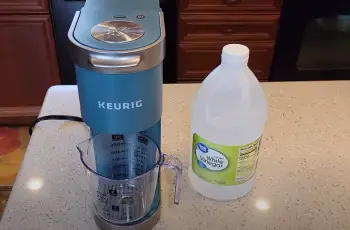How to make Hot Water with Coffee Maker?
Have you ever considered using a coffee machine to brew a simple cup of hot water? Have you pondered the possibility of boiling water in a coffee machine, yet uncertain if it’s a practical choice? Today, I’m going to show you how to turn this concept into reality, and you’ll discover whether or not it’s worth giving a shot.
Mechanism of Heating Water in a Coffee Maker:
Coffee makers are designed to make quick hot coffee, for which a coffee maker must be able to heat water to that extent. But do the coffee makers boil the water? To answer this question, let’s fort understand the simple heating mechanism of a dripping coffee maker.
- First, all drip coffee makers have a heating element in them that causes the heating of water. So it does bring the water to a boiling temperature, but we can’t see that happening because the boiling water doesn’t get released from the showerhead.
- At the bottom of the unit, there are heating coils, and this is the area where water gets boiled. The steam forms then move towards the upper room, causing the vapors to condense into liquid water whose temperature is slightly low from the boiling temperature. This is where the water drips out of the machine, and we can see it.
Structural Explanation of a Coffee Maker:
I have just shared a simple mechanism of how a coffee maker heats the water. But, there is more to it. To understand whether you should use a coffee maker for boiling water, you must understand in-depth the structure and functionality of a coffee maker. A coffee maker consists of the following parts:
- An aluminum or copper heating coil tube
- A showerhead
- An upper tube
- Water reservoir
What do these parts do inside a Coffee Maker?
- The aluminum or copper tube is located below the water reservoir. Using the principle of gravity, the water then falls into the tube. The heating tube then causes the boiling of water.
- This heating process turns the water into steam that then begins to move upward to the plastic tube.
- As the bubbles keep rushing towards the showerhead located on the top of the plastic tube, the steam begins to turn back into liquid water.
- The water then drips over the coffee ground, but its temperature is lower than the boiling temperature. This is because the time it takes to reach the plastic tube, and then the shower head causes it to lose some of its heat.
Factors that count in Heating the Water inside a Coffee Maker:
Certain factors count in heating the water to a desirable temperature.
Age of the maker: The older your coffee maker is, the lesser heated water it will provide. Researches have shown that over time the efficiency of coffee maker decreases. For instance, a new coffee maker can heat water to 195F, but after 7-8 months, this efficiency will reduce to 156F.
Salts and minerals: The minerals and salt content of water is another factor that reduces the maker’s capability. With time, salts and minerals build a layer over the heating coil, thus reducing its efficiency to heat the water.
Plastic tube VS pump: Some ordinary coffee makers contain a plastic tube to transfer the steam to the showerhead. This reduces the water temperature. At the same time, some fancy brands provide the coffee makers with a pump that quickly pushes the steam upward, thus providing more heated water in the coffee ground.
How Hotter the Water can get in a Coffee Maker?
Another thing to discuss is how much hotter water a coffee maker can provide. The simple answer is it can not compete with a water pot in terms of temperature. As I told you earlier, the ability to heat water reduces with the time and frequent use of the coffee makers. So after some time, you won’t get the desired heated water. Experiments have shown that old coffee makers are even unable to cross 150F. Whereas the optimal temperature for coffee, as suggested by the coffee association, is 195-205. The maximum temperature that a coffee maker can reach is 205F if you purchase a big brand. Another factor is that most coffee makers begin to push the water out of the shower headway before it gets its maximum temperature.
How you can use Heated Water in a Coffee Maker:
There are many ways in which a coffee maker can serve you:
- You can have your instant coffee
- You can heat water to make green tea
- You can sterilize some items in the coffee maker
- You can use instant heated water to make soup or sauces
- Coffee makers use less electricity and work faster to provide you with hot water
- A safe gadget to deal with the heated water
Downsides of a Coffee Maker:
Where there are many advantages of having a coffee maker, there exist some downsides too:
- You can’t expect hot boiling water to boil potatoes or chicken in a coffee maker
- You have to clean the coffee maker and remove the remnants of caffeine before you use it to heat plain water.
- Do not sterilize infants items in a coffee maker unless you remove even a minor remainder of caffeine from the maker. If ignored, it will contaminate the baby gadgets or water with caffeine.
Bottom line:
After all the experiments and discussion, we have concluded that you can use a coffee maker for some little hot water needs, but you can’t expect too much from this. It could be your instant coffee or tea partner, but it can never be your potato boiling or meat broiling pot. Cleaning and maintenance is another factor. Finally, as it is mainly used to brew coffee and tea, You can’t ignore caffeine in its parts and tubes.
So if you are thinking of using it to boil plain hot water for you, you must clean out all the residues of caffeine; otherwise, all you get is caffeine-contaminated water. I know that is the last thing you want. So I would suggest you better avoid using a coffee maker as your boiling hot water companion.


